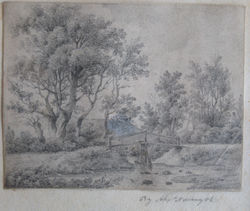Alexander Nasmyth, (1758-1840)
Alexander Nasmyth is generally regarded as the most important Scottish landscape painter. He was born on September 1758 in the family home in the Grassmarket, Edinburgh and studied in London and Italy. He influenced many Scottish artists - not least several of his own children, whom are recognised as artists in their own right.
While his ancestors had been landed gentry in the Lowlands his father and grandfather were involved with the construction of some of the earliest houses in what was to be known as the New Town. It is interesting that Alexander, although he did not go into the family business, was the designer of the Dean Bridge and St. Bernard's Well, the small temple overlooking the Water of Leith, and helped with the early plans for the New Town layout.
He studied at the Royal High School and the Trustees’ Academy and was apprenticed to a coachbuilder. Aged sixteen, he was taken to London by portrait painter Allan Ramsay where he worked on subordinate parts of Ramsay's works. Nasmyth returned to Edinburgh in 1778, where he worked as a portrait painter. Offered a loan byPatrick Miller of Dalswinton, Nasmyth left in 1782 for Italy, where he remained two years furthering his studies. In Italy he devoted most of his attention to landscape painting,
Nasmyth returned to Scotland where for the next few years he continued his career as a portraitist. He painted some works in the style of Ramsay, but most were conversation pieces with outdoor settings. His portrait of Robert Burns, who became a close friend, is now in the Scottish National Gallery. Eventually, Nasmyth’s strong Liberal opinions offended many of his aristocratic patrons in a politically charged Edinburgh, leading to a falling off in commissions for portraits, and in 1792 he completely abandoned the genre, turning instead to landscape painting. He also began painting scenery for theatres, an activity he continued for the next thirty years, and in 1796 painted a panorama.
Nasmyth died at home, 47 York Place (roughly opposite the house of Sir Henry Raeburn) in Edinburgh. He was buried in St Cuthbert's Churchyard at the west end of Princes Street.
 Alexander NasmythTaymouth Castle Oil on Canvas signed verso 18"x24" £6800 |
|---|
 The BridgePencil Inscribed 5x7 £850 |
 Cathedral RuinPencil 12x10 £875 |
His landscapes are all of actual places, and architecture is usually an important element. Some works were painted to illustrate the effects that new buildings would have on an area, such as Inverary from the Sea, painted for the Duke of Argyll to show the setting a proposed lighthouse.
He was employed by members of the Scottish nobility in the improvement and beautification of their estates. Nasmyth set up a drawing school and "instilled a whole generation with the importance of drawing as a tool of empirical investigation".
